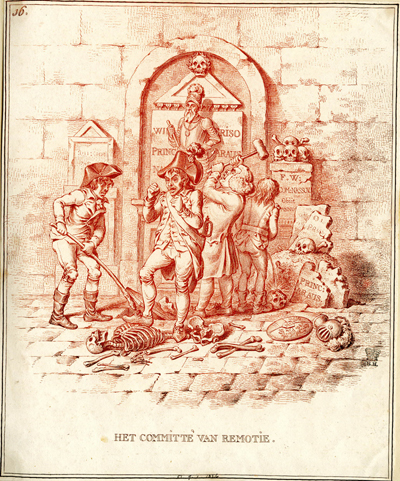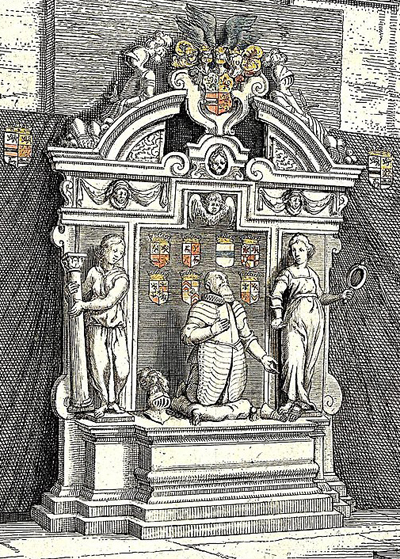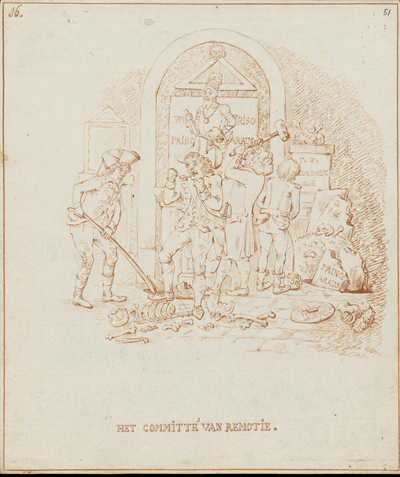Het Committé van Remotie
This is the sixteenth plate of a twenty plate series, Hollandia Regenerata, etched by Gillray based on drawings by the Swiss soldier, painter, and caricaturist, David Hess. For more about David Hess, and the political and artistic context of the series satirizing the newly-created and French-supported Batavian Republic, see my Introduction.
The title can be translated as "The Committee of Removal." Like the committees described in the previous two plates, this is a Committee invented by Hess for consistency with other titles in the series and for his own satiric purposes. The plate shows a group of Batavian soldiers and revolutionaries vandalizing a tomb. One man is prying off the stones of a grave. Another is trampling upon the bones of an exhumed body, a third is about to strike the principal effigy with a sledge hammer, while a young man urinates upon a skull.

Het
Committé van Remotie
[1796?]
© Trustees of the British Museum
As Joost Rosendaal notes, Hess found the inspiration for this print in the report that on August 1, 1795 the graves of the Nassau branch of Stadtholder's family in the Grote of Jacobijnerkerk in Leeuwarden (in Friesland) had been vandalized by order of the revolutionary rulers of that region. The crypt contained the graves of William Louis of Nassau-Dillenburg and William Frederick Prince of Nassau-Dietz, among seven others. The representation of the monument is not historically accurate, but the references to Wil[lem], Friso (i.e. Frisian), Princ[e], Araus (Latin for Orange) and Nassov (Nassau) all suggest that the statue is intended to represent William Louis whose grave was among those desecrated in 1795.

© Wikipedia
As with all the plates in the series, the corresponding page to the image contains one or more appropriately ironic Biblical quotations in Dutch and English and a satiric "Explanation" in French. The Biblical quotation makes clear Hess's revulsion for the senseless destruction of the graves:
Leviticus, xviii. 27. "All these abominations have the men of the land done."
The "Explanation." takes a more ironic approach to the same end.
C'est ainsi qu'en Frise les amis de la liberté ont détruit jus qu'à la mémoire de leurs anciens tyrans. Ils ont fouillé dans leurs tombeaux ; ils ont réduit en poussiere les débris de leurs ossemens, et ils ont fait retomber dans le néant les monumens de leur grandeur usurpée. Il est à esperer qu'en voyant cet image, on ne pensera pas a ces faibles animaux qui insulterent le lion apres sa mort. Ce serait faire une odieuse comparaison entre de zêlés révolutionnaires et les bêtes de la fable.
And here is my free English translation.
This is how in Friesland the friends of freedom erased the memory of their ancient tyrants. They searched their tombs. They reduced to dust the debris of their bones. They destroyed the monuments of their usurped greatness. It is to be hoped that by seeing this image, we will not think of those weak animals who insult the lion after his death. This would make an odious comparison between zealous people and the animals of the fable.
The fable referenced here is Aesop's "The Lion Grown Old" where a dying Lion is insulted by the animals who used to fear him, including a boar, a bull, and finally, an ass.

Het
Committé van Remotie
[1796?]
© Zentralbibliothek Zürich
Like most of the plates of Hollandia Regenerata, Gillray follows the Hess's drawing closely. The basic disposition of the figures and meaning of the print both derive from Hess. But Gillray has sharpened every line and, with a wonderful use of shading, given a depth and solidity to the monument and background stones of the church, the foreground flagstones, and all of the figures (especially their clothes) that is missing in the original Hess drawing. He has also improved the expression of the central figure and altered the area surrounding his right foot so that it does not get confused with the lifted flagstone.
Sources and Reading
- Commentary from the British Museum on Het Committé van Remotie.
- "Batavian Republic," Wikipedia
- "Grote of Jacobijnerkerk," Wikipedia
- "The Lion Grown Old," Wikipedia
- "David Hess (painter)," Wikipedia
- "David Hess," SIKART Dictionary
- David Hess, Hollandia Regenerata (1797), Nawoord by Joost Rosendahl, Uitgeverij Vantilt, 2007
- Simon Schama, Patriots and Liberators: Revolution in the Netherlands 1780 - 1813, London, 1992
Comments & Corrections
NOTE: Comments and/or corrections are always appreciated. To make that easier, I have included a form below that you can use. I promise never to share any of the info provided without your express permission.